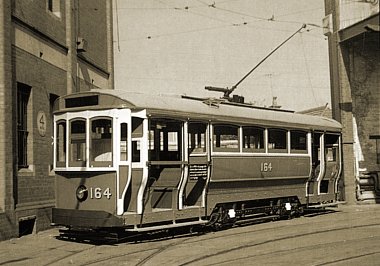Melbourne Tram Museum
- Follow Melbourne Tram Museum on Twitter
- Follow Melbourne Tram Museum on Facebook
- Follow Melbourne Tram Museum on Instagram
- Follow Melbourne Tram Museum on Pinterest
- Follow Melbourne Tram Museum on Tumblr
- Subscribe to Melbourne Tram Museum's RSS feed
- Email Melbourne Tram Museum
Melbourne & Metropolitan Tramways Board S Class No 164
This tram was built by Adelaide-based car builders Duncan & Fraser Limited in 1916 as part of a order for twelve tramcars for the Melbourne, Brunswick & Coburg Tramways Trust (MBCTT). It entered MBCTT service as No 11. The tramcar design is known as a single truck drop-end ‘California’ combination car, with a central closed saloon and open ends. This style of tramcar was first seen on the San Francisco cable tram system, and later adapted for use as an electric car design. The ‘California’ style car was a design compromise between a fully open tramcar such as NMETL No 13 and a fully closed saloon car.
Unlike its contemporary Hawthorn Tramways Trust No 8, it was built with a simple arch roof instead of the complex clerestory roof, the latter sometimes being called a ‘monitor’ roof. The arch style would come to dominate Melbourne tramcar construction. The car was designed by the Engineer and Manager of the MBCTT, Struan Robertson, who later held the same position with the Hawthorn Tramways Trust. This group of tramcars were the first in Melbourne to be built with brakes operated by compressed air, introducing the classic ‘dugga-dugga’ sound of the air compressor to Melbourne commuters.
 M&MTB S class No 164 at Malvern Depot, 1967.
M&MTB S class No 164 at Malvern Depot, 1967. - Photograph courtesy Dale Budd.
The tram was taken over by the Melbourne & Metropolitan Tramways Board in 1920. It was classified as an ‘S’ class tram in its roster and renumbered 164. It was allocated to a number of depots during its life, including Coburg, Preston, Brunswick and Malvern. During its life, it received no major modifications with the exception of fitting of a standard M&MTB destination box. In 1953 it was presented complete to the Australian Electric Traction Association, and transferred to the Tramway Museum Society of Victoria in 1963.
Along with T class No 180, it is the only surviving ex-MBCTT tramcar.
In 1992 it was placed on long term loan to the Victorian State Government as part of the Heritage Tramcar Fleet, and is now on display as part of the collection of the Melbourne Tram Museum.
Technical details
| Motors: | 2 x 55hp (GE 241) |
| Controller: | GE K36JR |
| Truck: | Brill 21E |
| Passengers: | 36 (seated), 74 (standing) |
| Weight: | 13.1 tons |
| Length: | 35 feet 0 inches |
| Width: | 8 feet 0½ inches |
Bibliography
Brill, D. (2001) History of the J.G. Brill Company, Indiana University Press
Cross, N., Budd, D., and Wilson, R. (1993) Destination City (Fifth Edition), Transit Australia Publishing
Cross, N., Henderson, R. and Kings, K. (1981) Destination City (Fourth Edition), Australian Electric Traction Association
Prentice, R. H. (1966) “A Brief History of the Melbourne, Brunswick and Coburg Tramways Trust”, Running Journal July 1966, Tramway Museum Society of Victoria